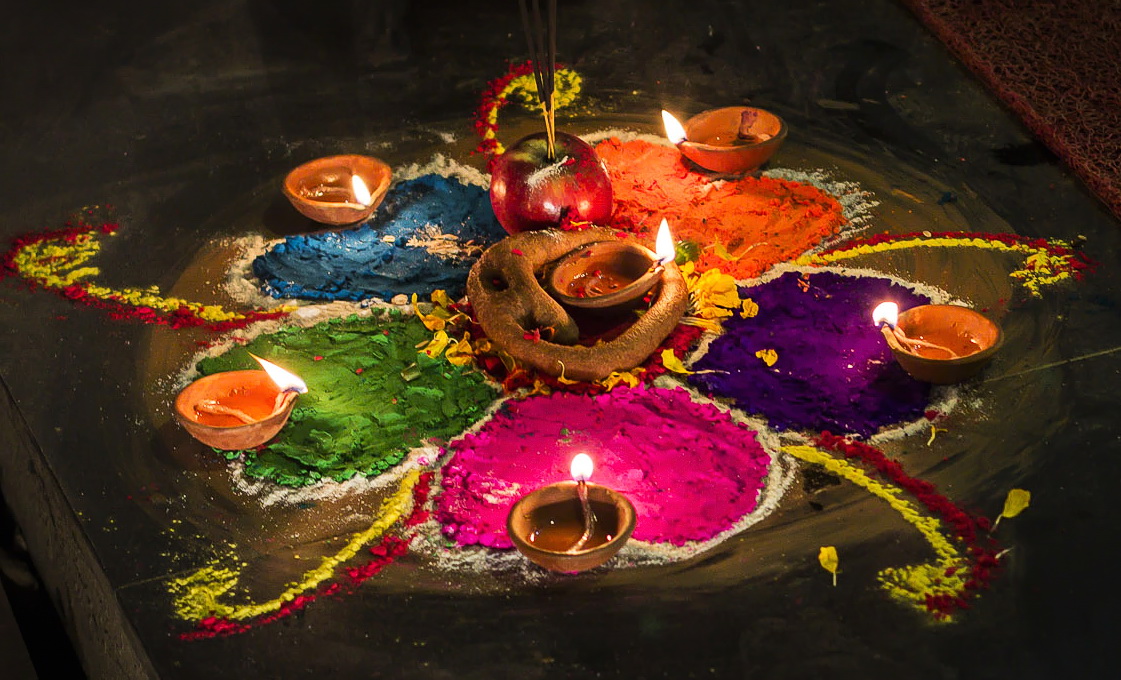Tihar is the festival of fire in Nepal
 Tihar is one of the main holidays of the year in Nepal. It is also called the festival of lights and Nepali new year. Tihar is held simultaneously with absenteesim the festival of Diwali (Deepavali) and is essentially its extended and localized version. The tribe nevarov (conditionally indigenous people of the Kathmandu valley) this holiday is known under the name of Svante. But the essence of the holiday is certainly not in his name, and his cheerful nature. All singing and dancing, fireworks and burn the lamps, decorated with flower garlands everything - from shopping to Pets.
Tihar is one of the main holidays of the year in Nepal. It is also called the festival of lights and Nepali new year. Tihar is held simultaneously with absenteesim the festival of Diwali (Deepavali) and is essentially its extended and localized version. The tribe nevarov (conditionally indigenous people of the Kathmandu valley) this holiday is known under the name of Svante. But the essence of the holiday is certainly not in his name, and his cheerful nature. All singing and dancing, fireworks and burn the lamps, decorated with flower garlands everything - from shopping to Pets.
In the fall of 2014, coming back from trekking to Annapurna base camp, we found ourselves in Kathmandu just in the midst of the festival Tihar. This festival lasts for 5 days. On the first day (CAG Puja) Nepalese salariat (fed sweets) normal Raven - Hinduism is the bird of sorrow and death. During the second day of Kukur Tihar) tasty food and is decorated with flowers pet dogs - need to placate them because they are also messengers of death. This stage of the holiday took us the way from Pokhara to Kathmandu, when we knew nothing about the upcoming festivities, and hung with chernobryvtsi dogs were perceived by us as another prank Nepalese children.

Returning to the capital we were in the midst of the festival. In the beginning of the third day (Gai Tihar) worship cows, but the evening begins this Gulina. By this time all the streets are decorated with lanterns, and before each house owners make rangoli. This is a complex geometric or floral" pattern (very similar to the Buddhist mandala), which carry powder paints, colored sand or rice right on the ground before entering the house.

In addition to the figure in the composition usually includes fruit, fragrant sticks fuming incense, and of course numerous bowls and lamps (Diya) with burning oil (ghee). After all, Tihar is the festival of lights symbolizing the victory of light over darkness, good over evil. No wonder the date of the holiday (usually late October) is determined by the lunar calendar and designate on the darkest night - the night of the new moon, after which it is broken and the light begins to besiege the darkness.

In the evening the city is not empty, but rather filled with people. The streets are worn crowds calabuig kids. They come in every house, in every shop and sing holiday songs. Girls own song (it's called Bhailo), and the boys - own (Deusire). In response, the owners treat them with sweets and give a little money (the standard fee is 5 rupees).

According to Hindu mythology, this custom went from the legendary king Bali, who met a wandering dwarf the Vaman (actually it was Vishnu himself) offered him any gift by choice. The dwarf asked a little land (exactly three steps) and when the king agreed, Vaman changed and the first two steps have covered the whole Universe and the third time step was already nowhere. Then the king offered to step on his head. For such generosity to the king promised the position of ruler of the universe. However, not now, and the distant future, after several millennia of waiting for purifying fire (note - and here, too, the fire).

Adults also very actively having fun, singing and dancing. Everywhere thundering fireworks, celebrating Nepali new year is in full swing. We, though, and a pale-faced foreigners, but have caught on to the festive atmosphere and slightly dancing went to wander the streets in the evening Kathmandu.

On the fourth day (theoretically dedicated to the worship of the ox), the festival has continued to rage for quite latinoamerikanski manner. Along the narrow and winding streets of Thamel to death, blocking traffic, slowly crawled caravan pickups with Amateur orchestras and dance floors. The young, well-heated Raksha (Nepali moonshine), all danced and waved flags. Even on foot to navigate the streets (we were looking for Souvenirs) was not easy - but it is terribly interesting and fun.

The last fifth day of the festival (Bhai Tika) we are not found, as flew home. On this day, brothers and sisters draw each other on the forehead of a special five-colored tick (point) and pray for long life and prosperity. For this custom, too, is a kind of legend of the sister trick saved the brother of the messenger of death.
Cyril Jasko, November 5, 2014